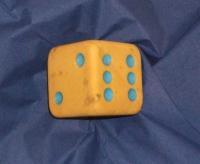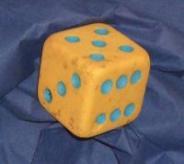Dicey Decisions
Problem
This problem follows on from Troublesome Dice.
Jenny and her family often roll a die to decide who gets to eat the last slice of pie, but when they roll it, the die often seems to land "edge-up" or "corner-up" on a napkin, so they roll again.
One day, Jenny suggests that instead of rolling again, when the die lands corner-up or edge-up, they simply add the visible faces together:


What assumptions would you need to make to come up with a fair way of determining who gets the last slice of pie?
Here are some questions you might like to consider:
Suppose the die lands face-up with probability $\frac {1}{2}$, edge-up with probability $\frac{1}{3}$ and corner-up with probability $\frac{1}{6}$. How could you allocate totals to three people to give each of them an equal chance of getting the last slice of pie?
Suppose the die lands face-up with probability $p$, edge-up with probability $q$, and corner-up with probability $r = 1-(p+q)$. Are there any family sizes for which you can always allocate totals fairly, regardless of the values of $p$, $q$ and $r$?
The relative frequency of face-up, edge-up and corner-up scores for the standard 6-sided die are distributed symmetrically. Can you explain why?
This problem is based on an idea shared by Paul Stephenson.
Getting Started
Student Solutions
Daniel from Savile Park School sent us a solution to the first part of the problem.
Here's a list of all the possible scores and how many possibilities they are for each score when an edge faces upwards:
| Score | Combination |
| 3 | (1,2) |
| 4 | (1,3) |
| 5 | (1,4), (2,3) |
| 6 | (1,5), (2,4) |
| 8 | (2,6), (3,5) |
| 9 | (3,6), (4,5) |
| 10 | (4,6) |
| 11 | (5,6) |
and another table for the possible scores and combinations for ending up a corner facing upwards:
| Score | Combination |
| 6 | (1,2,3) |
| 7 | (1,2,4) |
| 9 | (1,3,5) |
| 10 | (1,4,5) |
| 11 | (2,3,6) |
| 12 | (2,4,6) |
| 14 | (3,5,6) |
| 15 | (4,5,6) |
In the first case where the probabilities of landing with a face, edge or corner facing upwards are $\frac{1}{2}, \frac{1}{3}$ and $\frac{1}{6}$ respectively, the total probabilities of getting a number are shown in this table:
| Score | Probability | 144$\times$ probability |
| 1 | 1/12 | 12 |
| 2 | 1/12 | 12 |
| 3 | 1/9 | 16 |
| 4 | 1/9 | 16 |
| 5 | 5/36 | 20 |
| 6 | 23/144 | 23 |
| 7 | 1/48 | 3 |
| 8 | 1/18 | 8 |
| 9 | 11/144 | 11 |
| 10 | 7/144 | 7 |
| 11 | 7/144 | 7 |
| 12 | 1/48 | 3 |
| 14 | 1/48 | 3 |
| 15 | 1/48 | 3 |
We need to arrange the outcomes into sets so that the sum of the probabilities in each set are equal. For example, for 3 people, a possible arrangement is:
Person 1: scores of 1,6,7,10,12
Person 2: scores of 2,3,5
Person 3: scores of 4,8,9,11,14,15
These 3 sets all sum to $\frac{1}{3}$ as required. There are other solutions similar to this example as you can freely exchange scores 10 and 11, scores 3 and 4, scores 1 and 2 and scores 12,14 and 15, without changing the sums of the probabilities.
There are likely to be more solutions, have you found any others?
Meg, from All Hallows school, wrote to us with a solution for the second part.
When the dice lands on a face, edge or corner with probability p, q and r, the total probabilities for getting each score are:
| Score | Probability | 24$\times$ probability |
| 1 | p/6 | 4p |
| 2 | p/6 | 49 |
| 3 | p/6 + q/12 | 4p+2q |
| 4 | p/6 + q/12 | 4p+2q |
| 5 | p/6 +2q/12 | 4p+4q |
| 6 | p/6+ 2q/12 + r/8 | 4p+4q+3r |
| 7 | r/8 | 3r |
| 8 | 2q/12 | 4q |
| 9 | 2q/12 + r/8 | 4q+3r |
| 10 | q/12 + r/8 | 2q+3r |
| 11 | q/12 + r/8 | 2q+3r |
| 12 | r/8 | 3r |
| 14 | r/8 | 3r |
| 15 | r/8 | 3r |
If there are n members of the family, we need to split the outcomes into n sets, such that the sums of the probabilities in each set are constant (equal to 1/n) for all p,q and r.
This means we need to partition these numbers into sets so that the probabilities sum in each set to give the same quantity of p, the same quantity of q and the same quantity of r. These sums of probabilities will therefore be the same, whatever the values p, q and r take.
The sums will only involve integer multiples of 4p, 2q and 3r. We need to evenly split 6 multiples of 4p, 12 multiples of 2q and 8 multiples of 3r among n family members. What restrictions does this place on n? We need n to divide 6, 12 and 8, which implies n=2.
One possible arrangement is:
1) 1,3,5,8,10,12,14
2) 2,4,6,7,9,11,15
These sets both add up to 1/2. Again, there's degeneracy due to being able to interchange scores with the same probability.
Symmetry of probabilities:
The probabilities for the scores are symmetric because a cube, and therefore the set of possible scores, is unchanged if you interchange 1 and 6, 2 and 5, 3 and 4.
